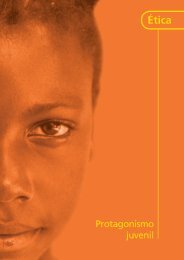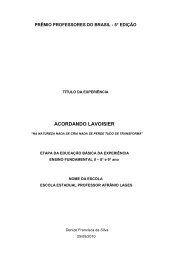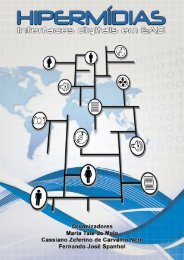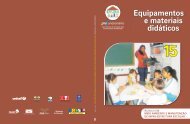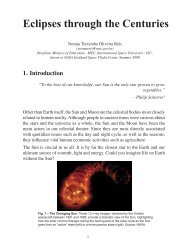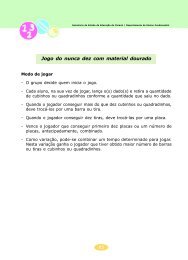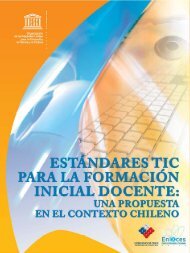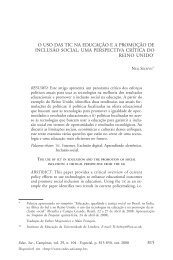BIO-CULTURAL COMMUNITY PROTOCOLS - Portal do Professor
BIO-CULTURAL COMMUNITY PROTOCOLS - Portal do Professor
BIO-CULTURAL COMMUNITY PROTOCOLS - Portal do Professor
Create successful ePaper yourself
Turn your PDF publications into a flip-book with our unique Google optimized e-Paper software.
PART II / CHAPTER 6<br />
Similar to the ABS context, an informed and empowered<br />
community is in a much better negotiating position than one<br />
that is uninformed about its rights and opportunities. It is also<br />
likely that a PES scheme built on a strong foundation such as<br />
the one created through the BCP process would be sustainable<br />
in the medium- or long-term, thus preventing high costs of<br />
renegotiating previous deals.<br />
5.4 Affirming Access and Land Rights<br />
Many countries in the developing world are characterized<br />
by legal plurality in determining who has access to or<br />
ownership over land and associated natural resources.<br />
These rights are granted under different legal systems that<br />
are often a fusion of international, national and<br />
customary law. They may be as diverse as the UN Declaration<br />
on the Rights of Indigenous People 30<br />
, formal land titles, rights<br />
through use, ancestral rights, or membership in communityowned<br />
or occupied land. 31<br />
One of the key contributions of a BCP in the context of PES<br />
schemes is the affirmation of ILCs’ existing rights to land or<br />
land use by listing all relevant national and international<br />
legal frameworks. When ILCs are in danger of being<br />
marginalized by a PES scheme, BCPs can help them clarify<br />
and assert their existing rights. Highlighting these rights<br />
legally empowers communities to enter into such schemes<br />
with confidence and understanding of their values and<br />
priorities. Given the centrality of clear land rights to the<br />
establishment of effective PES schemes, BCPs could provide<br />
further clarity about the legal status of ILCs and their use<br />
of land and natural resources.<br />
5.5 Determining Types of Payment<br />
In cases in which ILCs <strong>do</strong> not have clear access or rights to<br />
land, official land tenure could be granted in exchange for<br />
their agreement to engage in sustainable land use practices.<br />
Kerr et al. describe an example in In<strong>do</strong>nesia in which<br />
informal forest occupants that had previously engaged<br />
<strong>BIO</strong>-<strong>CULTURAL</strong> <strong>COMMUNITY</strong> <strong>PROTOCOLS</strong> IN THE<br />
CONTEXT OF PAYMENT FOR ECOSYSTEM SERVICES<br />
in detrimental agriculture agreed to refrain from such<br />
activities if they were given official land tenure and granted<br />
access to associated government services. 32<br />
Such non-monetary benefits are an example of the vast<br />
array of options available for the type of payments under<br />
PES schemes. Non-monetary benefits may be particularly<br />
useful in local contexts in which certain service provisions<br />
or the clarification of land tenure may be more important<br />
than monetary income. While many factors will influence<br />
the size and nature of payment possible, the visioning<br />
component of BCPs can help in establishing what type of<br />
payment would be most desired by ILCs.<br />
5.6 Addressing Possible Secondary<br />
Effects through a Bio-cultural Analysis<br />
of Existing Use of Biological Resources<br />
When entering into PES schemes, ILCs have to be aware of<br />
possible secondary effects such as the socio-economic<br />
impact of restricted future land use. While there is always a<br />
risk of unanticipated consequences emerging from the<br />
implementation of such schemes, the use of BCPs can<br />
reduce some of the associated risks.<br />
Part of the BCP process is a discussion about the nature of<br />
the current resource use of all members of the community;<br />
within a PES context, it will also include discussion about<br />
how the conditions attached to a PES scheme will affect<br />
such resource use. The designers of the PES scheme can then<br />
use the BCP to ensure that community members will not be<br />
adversely affected by the scheme and, in cases in which<br />
local land use practices have to be changed or stopped,<br />
to ensure that any negative consequences are mitigated<br />
wherever possible. On top of that, highlighting the<br />
communities’ bio-cultural values in this regard will further<br />
prevent cultural conflict emerging from certain land<br />
usage change.<br />
30. Article 26 of the UN Declaration on the Rights of Indigenous People:<br />
- Indigenous peoples have the right to the lands, territories and resources which they have traditionally owned, occupied or otherwise used or acquired.<br />
Indigenous peoples have the right to own, use, develop and control the lands, territories and resources that they possess by reason of traditional ownership or other<br />
traditional occupation or use, as well as those which they have otherwise acquired.<br />
- States shall give legal recognition and protection to these lands, territories and resources. Such recognition shall be conducted with due respect to the customs, traditions<br />
and land tenure systems of the indigenous peoples concerned.”<br />
31. Supra note 7.<br />
32. TRIP Report: Property Rights, Environmental Services and Poverty in In<strong>do</strong>nesia, by John Kerr et al., 2004: . Footnote 5 (UNEP 2008) also mentions land and access rights<br />
as a possible form of payment as part of a PES scheme.<br />
65




